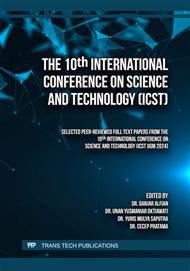[1]
Rosyida, A., Nurmasari, R., & Suprapto. (2019). Analisis Perbandingan Dampak Kejadian Bencana Hidrometeorologi dan Geologi di Indonesia dilihat dari Jumlah Korban dan Kerusakan (Studi: Data Kejadian Bencana Indonesia 2018). Jurnal Dialog Penanggulangan Bencana, 12-21.
DOI: 10.34126/jlbg.v12i1.303
Google Scholar
[2]
Fauzi, M., & Mussadun. (2021). Dampak Bencana Gempa Bumi dan Tsunami di Kawasan Pesisir Lere Kota Palu. Jurnal Pembangunan Wilayah dan Kota, 16-24.
DOI: 10.14710/pwk.v9i2.6534
Google Scholar
[3]
Younis, Z. A. (2021). Mobile Ad Hoc Network in Disaster Area Network Scenario: A Review on Routing Protocols. International Journal of Online and Biomedical Engineering.
DOI: 10.3991/ijoe.v17i03.16039
Google Scholar
[4]
Hanafi, Rachmawati, & Fatmawati, C. (2022). Analisis Kinerja Jaringan Manet Menggunakan Protokol Routing OLSR. Jurnal Listrik Telekomunikasi Elektronika, 13-19.
DOI: 10.30811/litek.v19i1.2851
Google Scholar
[5]
Mirza, S., & Bakshi, S. Z. (2018). Introduction to MANET. International Research Journal of Engineering and Technology, 17-20.
Google Scholar
[6]
Obidike, G., Nwabueze, C., & Onuzulike, V. (2018). Concept And Characteristics Of Mobile Ad-Hoc Network. International Journal Of Innovative Engineering, Technology And Science, 68-76.
Google Scholar
[7]
Vijayalakshmi, D., & Sweatha, M. (2018). A Survey on History and Types of Manet. International Journal of Emerging Trends in Science and Technology, 4310-4312.
Google Scholar
[8]
Hamatta, H., Zanoon, N., & Al-Tarawneh, R. (2018). Comparative Review for Routing Protocols in Mobile Ad-Hoc Networks. International Journal of Ad hoc, Sensor & Ubiquitous Computing (IJASUC),13-3.
DOI: 10.5121/ijasuc.2016.7202
Google Scholar
[9]
Tanenbaum, A. S., & Wetherall, D. J. (2011). Computer Network. Boston: Pearson Education, Inc.
Google Scholar
[10]
Susanto, B., Hariyanto, A., & Surateno. (2018). Performance Comparison of Proactive and Reactive Routing Protocol in Mobile Ad Hoc Network. Journal of Communications Vol. 13, 218-221.
DOI: 10.12720/jcm.13.5.218-224
Google Scholar
[11]
Wheeb, A. H., & Al-Jamali, N. A. (2022). Performance Analysis of OLSR Protocol in Mobile Ad Hoc Networks. International Journal of Interactive Mobile Technologies (iJIM), 106-119.
DOI: 10.3991/ijim.v16i01.26663
Google Scholar
[12]
Hanafi, Rachmawati, & Fatmawati, C. (2022). Analisis Kinerja Jaringan Manet Menggunakan Protokol Routing OLSR. Jurnal Listrik Telekomunikasi Elektronika, 13-19.
DOI: 10.30811/litek.v19i1.2851
Google Scholar
[13]
E. Baccelli, J.A. Cordero, and P. Jacquet, "OSPF over Multi-Hop Ad Hoc Wireless Communications", International Journal of Computer Networks and Communications, vol. 2, no. 5, September 2010.
DOI: 10.5121/ijcnc.2010.2503
Google Scholar
[14]
Kong, F.-s., & Cui, B.-b. (2017). Performance Evaluation of AODV, DSR and DSDV in Mobile Ad-hoc Network. ITA Annual International Conference on Information Technology and Applications. Beijing: ITM Web of Conferences.
DOI: 10.1051/itmconf/20171204007
Google Scholar
[15]
Utami, P. R. (2020). Analisis Perbandingan Quality Of Service Jaringan Internet Berbasis Wireless Pada Layanan Internet Service Provider (ISP) Indihome dan First Media. Jurnal Ilmiah Teknologi dan Rekayasa, 125-137.
DOI: 10.35760/tr.2020.v25i2.2723
Google Scholar
[16]
Aschenbruck, N., Gerhards-Padilla, E., & Martini, P. (2009). Modeling Mobility in Disaster Area Scenarios. International Journal Performance Evaluation, 773-790.
DOI: 10.1016/j.peva.2009.07.009
Google Scholar
[17]
Milayanti, M. D., & Sabiq, A. (2022). Analisis Kinerja Protokol Routing ZRP dan TORA Pada Komunikasi Berbasis MANET dan WMN Untuk Penanggulangan Daerah Bencana. Jurnal Transformatika, 32-43.
DOI: 10.26623/transformatika.v20i1.5184
Google Scholar
[18]
G. Walunjkar and A. K. Rao, "Performance Evaluation of Routing Protocols in Large Size Disaster Scenario", International Journal of Recent Technology and Engineering (IJRTE), vol. 9, no. 2, pp :4200-4204, Jul 2019
DOI: 10.35940/ijrte.B3389.078219
Google Scholar
[19]
Segara, A. J., Wijayanto, A., Gustalika, M. A., & Ramadhani, A. D. (2022). Implementasi Mobile Ad-Hoc Network Pada Kawasan Pasca Bencana Dengan Routing Protokol DSR. Jurnal Riset Komputer STMIK Budi Darma, 834-839.
DOI: 10.30865/jurikom.v9i4.4508
Google Scholar
[20]
Barnes, P. (n.d.). About NS-3. Retrieved from NS-3: nsnam.org.
Google Scholar
[21]
Subektiningsih, Renaldi, & Ferdiansyah, P. (2022). Analisis Perbandingan Parameter QoS Standar TIPHON Pada Jaringan Nirkabel Dalam Penerapan Metode PCQ. Jurnal EXPLORE STMIK Mataram, 57-63.
DOI: 10.35200/explore.v12i1.527
Google Scholar
[22]
BNPB. (2018). Laporan Harian PUSDALOPS BNPB. Jakarta: Badan Nasional Penanggulangan Bencana (BNPB)
DOI: 10.29313/mediator.v10i2.3007
Google Scholar


